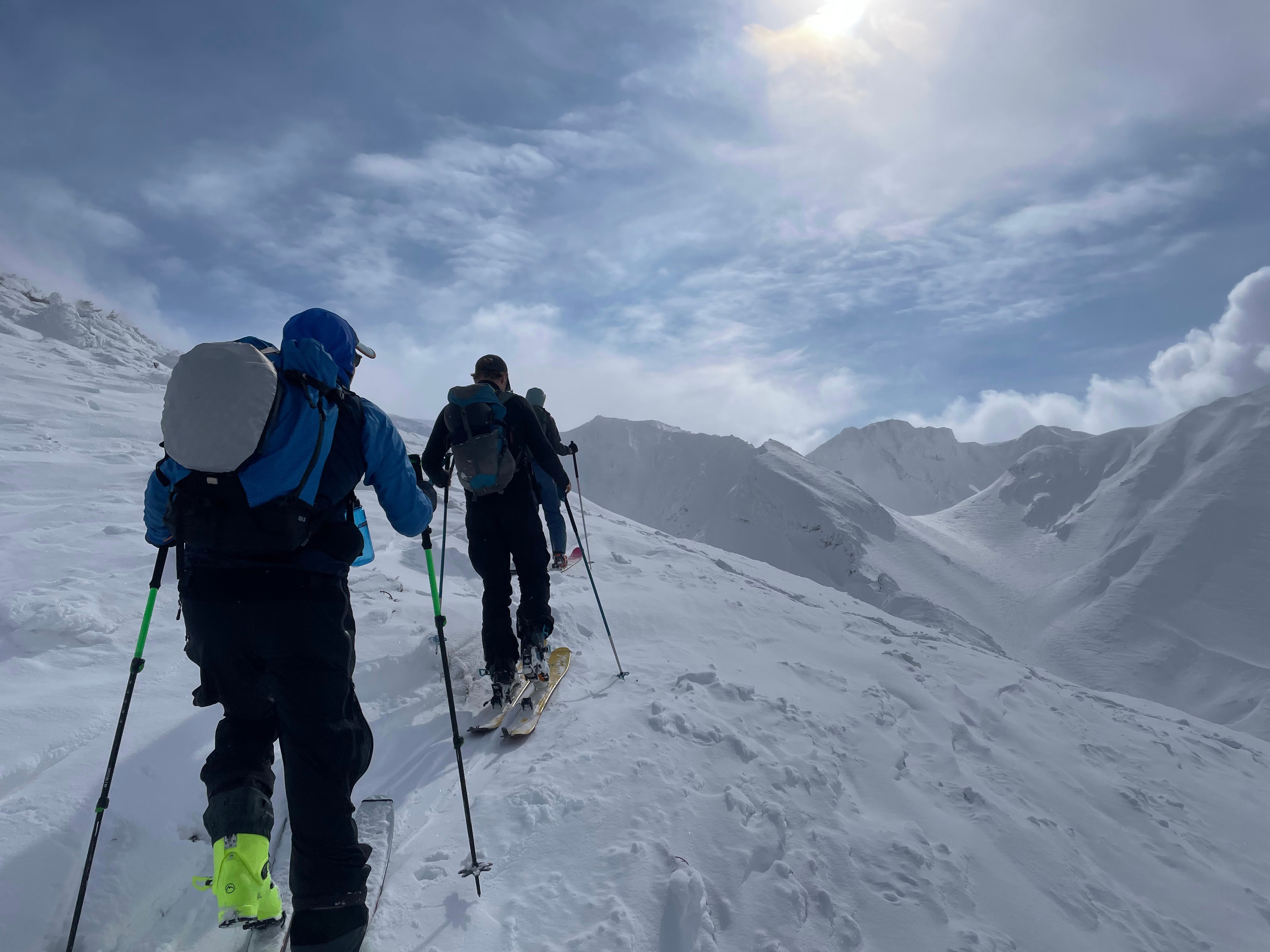Whether you're strapping on skis for the first time or have already tackled a few runs on the slopes, ensuring you have a solid foundation of the basics of skiing is essential before you trek out for your first backcountry expedition. Beginner skiers, in particular, can benefit a ton from starting with the fundamentals of ski gear, terminology, and technique, even before the first ride up the ski lift.
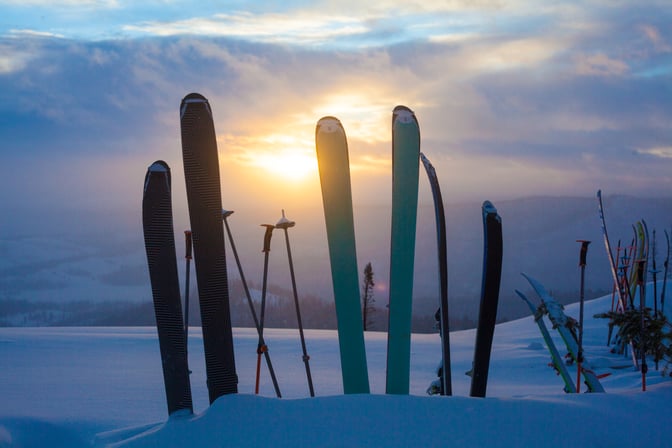 Photo by Molly Hagbrand
Photo by Molly Hagbrand
At NOLS, our experienced and passionate instructors teach equally passionate skiers the essential skiing techniques while emphasizing personal and community growth, leadership development, and risk management. Our goal is to help you not only learn how to ski but also gain a holistic experience that goes beyond the slopes.
While our skiing courses are designed to accommodate students of varying abilities, catering to those with basic, intermediate, and advanced experience, we recommend that first-time skiers take a few ski lessons before enrolling in one of our courses.
Start by familiarizing yourself with the following terms and skiing equipment, and get into the learner's mindset!
What Beginner Skiers Should Know
As you embark on the exciting journey of learning to ski, a crucial initial stride involves acquainting yourself with the fundamental terminology commonly used by instructors and becoming familiar with the essential ski gear integral to your first ski trip.
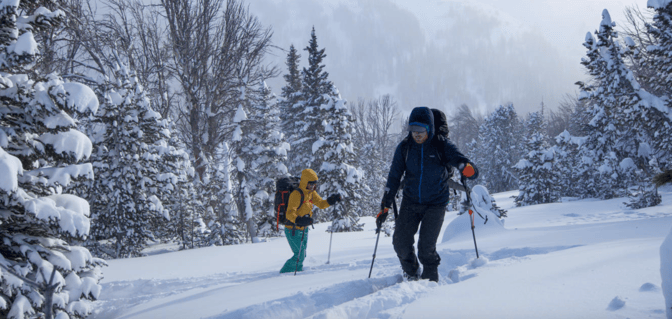 Photo by Molly Hagbrand
Photo by Molly Hagbrand
An Introduction to Ski Terminology
Types of Skiing
- Backcountry Skiing: Backcountry skiing attracts adventure seekers who navigate unmarked and undeveloped areas beyond ski resorts. Often involving hiking or skinning, this form of skiing grants access to remote and untamed terrain, delivering an authentic and challenging experience. NOLS skiing courses take place mostly in the backcountry.
- Alpine Skiing: Alpine skiing represents the most prevalent form of downhill skiing, distinguished by securing the heel of the boot firmly to the ski. This traditional method provides skiers with an exhilarating descent down well-groomed slopes.
- Uphill Skiing: Also known as skinning, uphill skiing requires attaching climbing skins to skis, enabling enthusiasts to ascend slopes and navigate the ski area in a unique and challenging manner. This dynamic form of skiing combines elements of endurance and technique.
Skiing Technique Terms
- Carving: Carving involves making precise turns on the snow by leaning into the edges of the skis. This advanced technique enhances control and maneuverability on the slopes.
- Snowplow: A foundational skiing technique, the snowplow involves angling the tips of the skis toward each other in a V-shape to control speed, making it ideal for beginners.
- Snowplow Turn: Initiating a turn using the snowplow technique, this maneuver is fundamental for skiers mastering the basics of controlled turns.
- Parallel Turns: Parallel turns are executed by turning both skis simultaneously, maintaining a parallel position. This technique is essential for advanced skiers seeking fluid and efficient turns.
- Yield: Yield refers to the responsibility to avoid collisions, typically assigned to the skier or rider below on the slope.
Snow Conditions, Trails, and Areas
- Groomed Run: A groomed run is a ski trail meticulously maintained and flattened by grooming machines, providing skiers with a smoother and more enjoyable skiing experience.
- Moguls: Moguls are bumps on a ski slope formed, requiring specific navigation techniques. They present an additional challenge for skiing enthusiasts.
- Powder: Powder is fresh, soft snow that has not been groomed or packed down. Skiing on powder offers a distinct and exhilarating experience compared to groomed trails.
- Piste: A piste is a marked and maintained ski trail, often graded by difficulty. Skiers can choose pistes that match their skill level for a tailored experience.
- Terrain Park: Terrain parks are designated areas with features like jumps, rails, and boxes, providing recreational skiers with opportunities for freestyle skiing and snowboarding.
Ski Lift Terms
Ski lifts are common at ski resorts, providing skiers with convenient transportation up the mountain before a downhill ski. Here are common types of ski lifts and their definitions:
- Chairlift: A chairlift is a lift where skiers are seated on chairs suspended from an overhead cable, facilitating efficient transportation to elevated slopes.
- Gondola: A gondola is an enclosed lift that carries skiers up the mountain in cabins, offering protection from the elements during the ascent.
- T-Bar: A T-Bar is a surface lift where skiers are pulled uphill by a T-shaped bar, providing an alternative means of ascending slopes.
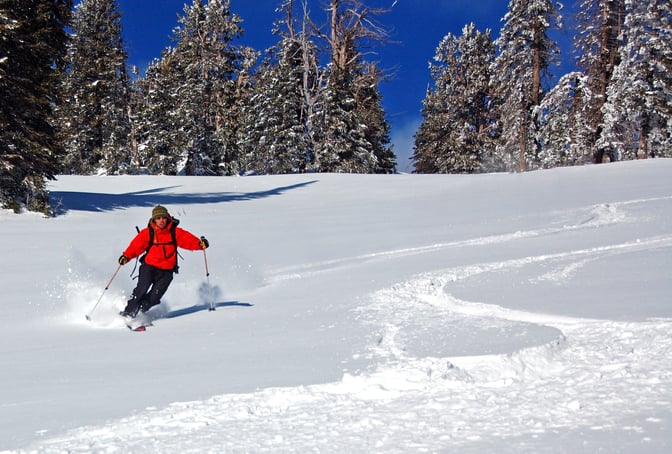 Photo by Brian Fabel
Photo by Brian Fabel
Ski Gear Basics and Essentials
As you embark on your first skiing adventure, it's crucial to acquaint yourself not only with essential skiing terms but also with the fundamental gear that will enhance your overall experience. Here's an overview of key ski gear basics:
- Ski Boots: These boots provide crucial ankle support and securely connect to the ski bindings, ensuring optimal control and responsiveness while navigating the slopes.
- Skis: As the primary equipment for gliding on snow, skis come in various types tailored to different skiing styles. Understanding the nuances of ski varieties will enhance your performance and enjoyment on the mountain.
- Ski Poles: Designed for balance, stability, and maneuvering, ski poles play a pivotal role in assisting skiers as they navigate diverse terrains. Proper use of ski poles enhances control and contributes to an efficient and enjoyable skiing experience.
- Ski Helmet: Safety is paramount in skiing, and a ski helmet is a non-negotiable component of your gear. It provides essential protection against potential falls and collisions, ensuring your well-being on the slopes.
- Ski Goggles: Shielding your eyes from wind, snow, and glare, ski goggles are indispensable for maintaining clear vision and protecting your eyes in varying weather conditions. Investing in quality goggles enhances both safety and visibility during your skiing endeavors.
- Bindings: Bindings are intricate mechanisms that connect your ski boots to the skis. They play a crucial role in controlling your movements and are designed to release in the event of a fall, preventing potential injuries. Understanding how bindings function contributes to a safer skiing experience.
- Edges: The metal strips along the sides of your skis are known as edges. These components grip the snow, facilitating precise turning and control. Knowledge of how to utilize ski edges effectively enhances your ability to navigate slopes with confidence and skill.
- Skins: Skins are specialized strips attached to the base of skis for ascending slopes. These skins provide traction against the snow, preventing backward sliding and enabling skiers to climb uphill efficiently. Skins are not needed for resort skiing.
- Wax: This refers to a specialized wax that is applied to the base of skis to enhance glide and performance. Proper waxing contributes to smoother movements on the snow and is essential for maintaining the longevity of your ski equipment. Understanding the basics of waxing is key to optimizing your skiing experience.
Choosing the Right Gear for Your First Ski
The great thing for beginner skiers is that many ski resorts offer options to rent skis, ski boots, ski poles, helmets, and even goggles. This allows you to get a feel for skiing before investing in your own gear.
When you're ready to commit to your own gear, start with the essentials such as comfortable ski boots, emphasizing a snug fit with guidance from local ski professionals to enhance confidence on the slopes.
Opt for a helmet that balances lightweight construction, efficient ventilation, and a secure fit, ensuring both comfort and safety. The choice of goggles is crucial for visibility and protection against varying elements, so select options that offer clear sight and effective shielding, tailored to different weather conditions.
These key gear elements contribute to an overall positive and enjoyable skiing experience. Make sure to consult with professionals at your local ski shop who can help you find the right fit.
Foundational Skiing Skills with NOLS
Gaining sufficient practice in the art of steering and turning while on skis is a fundamental skill that lays the foundation for an enjoyable experience on the slopes.
At NOLS, we help our students establish a robust foundation in essential ski movement techniques, equipping them for success during their backcountry skiing course.
This foundation encompasses a comprehensive understanding of the mechanics of steering, turning, braking, speed control, uphill skiing, and other basic maneuvers. These skills form the bedrock for navigating snowy landscapes with control.
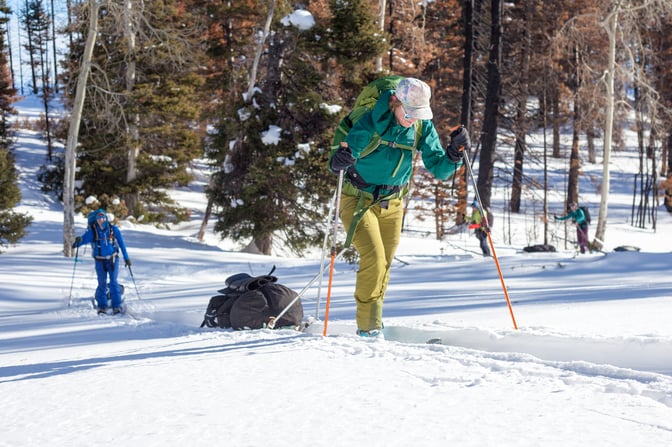 Photo by Molly Hagbrand
Photo by Molly Hagbrand
Steering and Turning in Skis
The essence of skiing lies in your ability to navigate smoothly down the mountain and through the snow. While this may sound obvious, learning how to ski a straight line, steer to the left or right, and make tight or wide turns can be awkward at first.
Your skis have two edges - the inside edge and the outside edge. To initiate a turn, focus on shifting your weight to the balls of your feet and gently pressuring the inside edge of the ski in the direction you want to turn. This engages the edge and directs your skis with precision.
As you initiate a turn, lean forward with your upper body slightly in the direction you want to go. Keep your arms forward and elbows relaxed, and maintain a forward-facing posture. This enhances your balance and helps you engage your edges effectively, making turning more fluid and natural.
Practice making S-shaped turns on a gentle hill (like a bunny hill) before progressing to steeper ski areas. As you become more comfortable, experiment with varying the size and shape of your turns to gain better control and confidence.
How to Uphill Ski
Uphill skiing, also known as ski touring, is a form of skiing that involves ascending slopes under one's own power and then descending them.
Skiing uphill requires specialized equipment tailored for both ascents and descents, which includes touring skis, bindings that liberate your heels during uphill travel, and climbing skins that provide traction.
First, make sure to affix the climbing skins to the skis so that they are in proper alignment. Then, adjust the bindings to the uphill mode, granting movement to your heels.
As the ascent commences, you'll walk uphill with a rhythmic shuffling motion, leaning your weight forward and poles assisting in balance and propulsion. Ski poles adjusted to a longer length play a crucial role in the ascent, as you'll use them to propel yourself upward, keeping balance as you firmly plant them in the snow. Techniques like switchbacks or a straight ascent may be employed depending on the slope's steepness.
Upon reaching the summit, you can transition bindings back to ski mode, peel off and stow away the climbing skins, and begin the descent in the fashion of conventional alpine skiing.
Proper Body Positioning for Balance and Stability
Maintaining the right body position is essential for balance and stability while skiing, especially in windy or steep conditions.
First, bend your knees slightly and keep your weight centered over the middle of your skis. Get familiar with your center of gravity. This neutral stance allows for better control and responsiveness.
Understanding and managing your center of gravity is vital for maintaining stability on the slopes. Your center of gravity should be positioned over the middle of your skis, creating a solid base. Avoid leaning too far forward or backward, as this can disrupt your balance and hinder your ability to turn smoothly.
Practice shifting your weight from one ski to the other while maintaining your balance. This dynamic movement is essential for controlling your turns and adapting to the varied terrain you may encounter.
Speed Control: Easing on the Brakes
Knowing how to control your speed is one of the most important aspects of skiing, especially for beginners.
Practicing the "pizza" or wedge technique is a great way to manage your speed effectively. While keeping the skis parallel will allow you to pick up speed, if you want to slow down or come to a stop, gently direct the front tips of your skis together, allowing the tails to remain outward, forming a wedge shape. This widens your base and increases the friction with the snow, acting as your brakes.
As you gain confidence, feel free to experiment with widening or narrowing the wedge to control your speed on different slopes. Remember, gradual and controlled movements are the key to mastering speed control without sacrificing balance.
Our courses provide a well-rounded and immersive learning experience, allowing you to develop these foundational skills further and gain confidence in applying them across diverse terrains and conditions.
Focusing on these fundamentals improves your skiing efficiency, and decreases the risk of accidents. As our students progress, NOLS instructors introduce more advanced techniques, including navigating challenging terrain, adapting to varying snow conditions, and managing avalanche training and rescue risk management.
More Ski Tips for Beginners
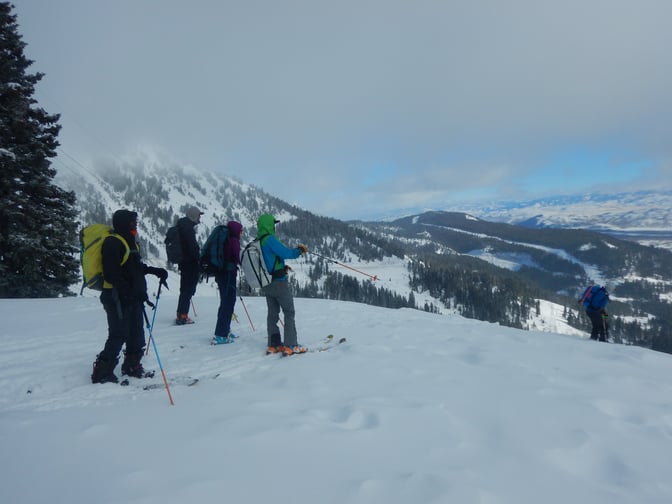 Photo by William Jahncke
Photo by William Jahncke
Adopting a Growth Mindset
Embarking on your first skiing adventure can be both thrilling and nerve-wracking. As a beginner skier, focus on mentally preparing yourself for the inherent challenges of skiing and the learning curve that you will inevitably experience.
Approach the experience with a learner's mindset as you confront new challenges. Stay open to feedback, ask questions, and fully embrace the learning process. Collaborate closely with both your skiing partner and course instructors to cultivate technical skills and leadership abilities.
Physical Readiness
Skiing involves a combination of whole-body strength, technique, and endurance. Many first-time skiers choose to start a basic strength and endurance routine at home, including activities like walking and basic exercises.
Strengthening your lower body, core, and cardiovascular system through exercises like squats, lunges, and core workouts is vital for enhancing stability and endurance on the slopes. To achieve fluid skiing movements, you can incorporate stretching routines targeting your legs and hip flexors, thereby improving your range of motion and minimizing the risk of injuries.
Refining balance and coordination through practices like yoga or balance exercises can also benefit you on the slopes. You can also integrate activities such as walking, running, cycling, or swimming into your fitness routine to bolster endurance and stamina. Remember, injury prevention is key, so listen to your body, know when to rest, and allow time for recovery.
Moreover, becoming intimately familiar with your skiing equipment, from the intricacies of putting on and taking off boots to understanding bindings, is paramount. Cultivating comfort with your gear significantly contributes to an overall smoother and more enjoyable skiing experience.
Before enrolling in a NOLS skiing course, we do recommend taking a few skiing lessons to get comfortable with the basic techniques and start building the muscle memory associated with skiing.
Backcountry Skiing Preparation
At NOLS, our skiing expeditions take place in the backcountry, which presents unique challenges and risks, especially for those without proper avalanche training.
Venturing into unmarked and unpredictable backcountry terrain without the necessary skills can lead to life-threatening situations. It is imperative for anyone interested in backcountry skiing to prioritize avalanche training and risk management, as well as the technical skills associated with skiing.
Dangers of Backcountry Skiing Without Avalanche Training
Backcountry skiing introduces a heightened level of risk due to the potential for avalanches, and this risk is significantly increased for individuals without proper training.
Avalanche terrain demands a comprehensive understanding of snowpack stability, weather conditions, rescue techniques, and route planning. Without this knowledge, skiers may unknowingly expose themselves to avalanche-prone areas, leading to severe consequences.
Importance of Avalanche Training and Certification
To mitigate the risks associated with backcountry skiing, we strongly advise you to participate in specialized avalanche training. Our winter courses include avalanche training and certifications to equip skiers with the essential skills needed to make informed decisions in avalanche-prone terrain.
Interested in learning more? Check out our Teton Valley Backcountry Avalanche Training (TVA) course!
Key Recommendations for Backcountry Skiing:
- Never Go Alone: Avoid venturing into the backcountry alone. Always ski with a partner or a group to enhance safety through teamwork, communication, and mutual support.
- Get Proper Training: Enroll in an avalanche training course to understand the intricacies of snow science, terrain assessment, and rescue techniques. Certification provides a solid foundation for making sound decisions in avalanche-prone areas.
- Practice Risk Management: Develop a habit of assessing risks and making informed decisions based on current conditions. This includes staying updated on weather forecasts, snowpack conditions, and recent avalanche activity.
- Carry Essential Safety Gear: Always carry essential avalanche safety equipment, including an avalanche beacon, probe, and shovel. Ensure you know how to use this equipment effectively.
- Know Your Limits: Be honest about your skiing abilities and fitness level. Avoid pushing beyond your limits, especially in unfamiliar and challenging terrain.
- Stay Informed: Regularly update your knowledge of backcountry safety and avalanche awareness. Conditions can change rapidly, and staying informed is crucial for making real-time decisions.
Remember, backcountry skiing is an exhilarating but potentially hazardous activity. Prioritize your well-being and that of those around you by investing in proper avalanche training and consistently practicing responsible backcountry skiing habits.
Ready to Get Started?
Your transformative skiing experience begins with a solid foundation and a commitment to continuous learning. Countless beginners, like yourself, have embarked on a life-changing skiing journey with NOLS after a few initial lessons and some studying of essential skiing terms, gear, and techniques.
We offer immersive skiing courses & certifications that include the essentials of avalanche training and backcountry terrain risk management, including courses for those who are newer to skiing:
- Fall Semester in the Rockies with WFR
- Spring Semester in the Rockies with WFR
- Fall Semester for Outdoor Educators
- Spring Semester for Outdoor Educators
- Spring Semester in the Rockies
Our experienced instructors guide you through the intricacies of skiing techniques while emphasizing avalanche risk management, personal growth, and leadership development.
Get ready to carve your path and traverse the snowy terrain with NOLS!
As a note, we recommend that total beginners take a few skiing lessons before enrolling in a NOLS course.
Written By
NOLS
NOLS is a nonprofit global wilderness school that seeks to help you step forward boldly as a leader.



